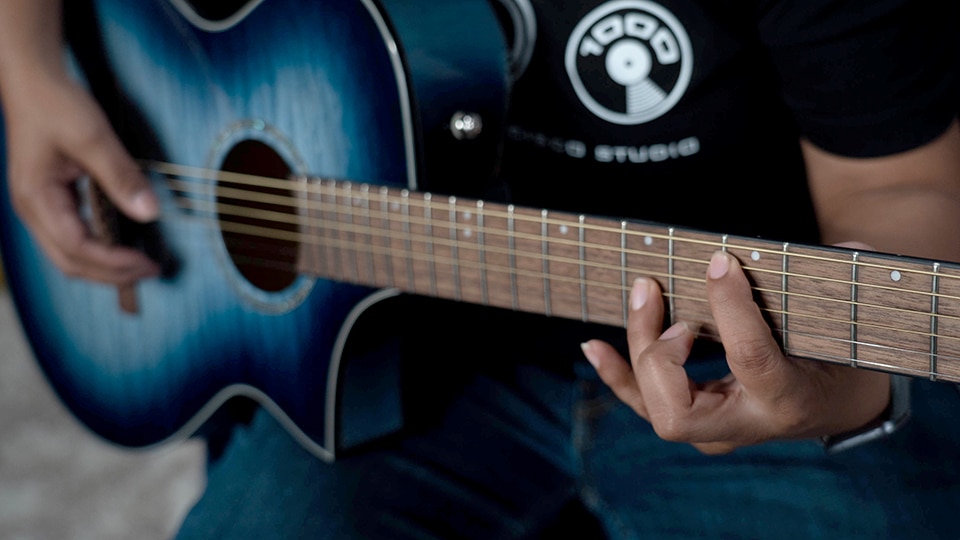By Margaret Jones
When you're getting started, sometimes it's easy to feel discouraged by discomfort when you're practicing. Your hands may get tired and your fingertips may become sore. You might even see an indentation where the string was pressing into your finger. While this irritation is unpleasant, it's nothing to worry about -- it will go away once you finish playing. Unfortunately, there's not much you can do to avoid this kind of pain completely, but the good news is that playing regularly will help you to grow calluses on your fingertips, which will protect them from the strings as you play. A little time and patience go a long way. The even better news is that a lot of discomfort can be minimized or avoided entirely by developing good practice habits.
![[RS+] "Why Do My Fingers Hurt?" - lespaul fingers 960](http://staticctf.ubisoft.com/J3yJr34U2pZ2Ieem48Dwy9uqj5PNUQTn/4Kfgyv13uZ1Pc0s4osW6JT/e5060f2b6f400e4f3366ae325f0968b1/lespaul_fingers_960.jpg)
If you're having trouble pressing down the strings, start higher up the neck at the seventh fret and move closer to the nut once you get a good sound there.
Start by analyzing your posture and playing technique. Are you hunched over or slouching when you play, or are you sitting up straight with your shoulders square? Are your wrists straight or bent at dramatic angles? This one's important – if you feel soreness in your wrists or muscles, that's a clear sign that you're putting strain on delicate tendons in your wrists. It's important to fix your posture early so you don't develop problems later on. Finally, take a look at how hard you're pressing down the strings. You probably don't need to press as hard as you think you do to get a clean sound. If your fingers are placed well – right behind the fret and centered on the string – a little pressure goes a long way.
![[RS+] "Why Do My Fingers Hurt?" - jazzguitar sitting 960](http://staticctf.ubisoft.com/J3yJr34U2pZ2Ieem48Dwy9uqj5PNUQTn/gU1tWtw9uBPogRzseGF28/51a635d26457b52995045c184f6cce78/jazzguitar_sitting_960.jpg)
Good posture can help to keep your wrists aligned and your fingers making precise contact with the strings.
If the strings still hurt your fingertips, it might be time to change the strings themselves. A fresh set will breathe new life into your guitar, but switching to a lighter gauge (say, a set of "nines" if you had been playing on "tens") often makes it easier to press the strings down. You also may want to consider trying out an acoustic guitar with nylon strings (which are also softer and easier to play). Also, consider taking your guitar in for a proper setup. Not only will your guitar tech check the guitar for any defects that could prevent it from playing well, but they can also adjust the "action" of the strings – the distance between the strings and the fretboard – to make it easier to play. It's a worthwhile investment.
![[RS+] "Why Do My Fingers Hurt?" - nylonstrings 960](http://staticctf.ubisoft.com/J3yJr34U2pZ2Ieem48Dwy9uqj5PNUQTn/2XDXBuXzmx3IkzvHDnSEV7/29375012b35368587d07f235a1032ff6/nylonstrings_960.jpg)
Many players find nylon strings to be gentler on their fingers.
Finally, don't be afraid to take a break. Shorter, more frequent sessions can help you progress much more quickly than powering your way through longer more uncomfortable ones. If you can, keep the guitar out on a stand so you're more likely to pick it up and play it any time you have a few minutes to spare. You'd be amazed how much more playing you can sneak in if you don't have to set everything up and pack it back down every time you want to practice. Stay patient, keep working, and it will get easier – and less painful!
Margaret Jones is a multi-instrumentalist, songwriter, and music teacher living in Oakland, CA. She plays guitar in several local bands including her own songwriting project M Jones and the Melee. She also holds a Ph.D. in Music History from UC Berkeley and has taught at the San Francisco Conservatory of Music.
Man guitar hands by Pexels is licensed by Pixabay.
Guitar by bogitw is licensed by Pixabay.
Additional photos by Katrin Auch, used with permission.
Learning a song is even easier with Rocksmith+, where you can take advantage of powerful practice tools, accurate note detection, and real-time feedback. Click here for more.









